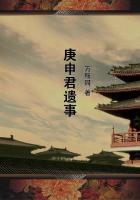The same judgment may be extended to the Farnese Bull, the work of Apollonius and Tauriscos, artists from Tralles who lived at Rhodes. This group represents the punishment of the cruel Dirke at the hands of the sons of Antiope. The beautiful queen clasps the knee of one of the sons praying for grace, while the other boy is about to throw over her the noose which is to bind her to the bull. Antiope stands in the background, a mere lay figure, and scattered about are numerous small symbolical figures. Like the Laocoon the Farnese Bull exhibits surprising mastery of technical obstacles, but, like the Laocoon, it falls short of true tragic grandeur. In a greater degree than the Laocoon it trenches upon the province of painting. It is more complicated in its subject-matter; and the appearance in the group of many small subsidiary figures, which in a painting might have been given their proper value, being in the marble of the same relief and distinction as the major characters, give a somewhat absurd effect. The little goddess who sits in the foreground, for instance, is smaller than the dog. Again, there is less of the motive shown than in the Laocoon. The group is seized at the moment preceding the frightful catastrophe, but that moment is as full of agony as the succeeding ones, and in addition there is the feeling of suspense and oppression that comes from the unfinished tragedy. Altogether, the group, in spite of the marvellous technical skill shown in details, is a failure when judged on general lines. Its interest lies in momentary and apparently ummotived suffering, not in any truly serious conception of life.
With the conquest of Greece by Rome, the final stage of Greek art begins. But the vigor and originality had departed. The sculptors aimed at and attained technical correctness, academic beauty of form, sensuous feeling, perfection of details, but they lost all imaginative power. A good example of the work of this period is found in the Apollo Belvidere now in the Vatican. This famous statue is an early Roman copy of a Greek original. It represents the god advancing easily, full of vigor and grace. It is marvellously correct in drawing, but quite without feeling of any kind.
Another work of this period is the sleeping Ariadne of the Vatican. This represents a woman reclining in a studied sentimental attitude, her arms thrown about her head, her body swathed in its protecting drapery. To the same period also belongs almost the last notable work of Greek art, the degenerate and sensuous conception of the Venus de Medici. In this statue the goddess stands as if rising from the sea, her attitude reserved, yet coquettish and self-conscious. The form is technically perfect, graceful, and soft in its refinement, but compared with the earlier Aphrodites it is an unworthy successor.
Still another famous statue is the Borghese Gladiator, of Agasius of Ephesus, now in the Louvre. The statue is merely a bit of display, an effort to parade technical skill and anatomical knowledge. The gladiator throws his weight strongly on his right leg, and holds one arm high above his head, giving to his whole body an effect of straining. The figure is strong and wiry.
Agasius was distinctly an imitator, as were most of the artists of this age, among whom must be reckoned the skilful sculptor of the crouching Venus, also in the Louvre. The goddess is shown as bending down in graceful curves until her body is supported on the right leg, which is bent double. The form is strong and healthy, graceful and easy in its somewhat constrained posture.
During all of this final period Greek art was very largely influenced by the relations which existed between Greece and Rome. About the year 200 B.C. the Roman conquest of Greece led to an important traffic in works of art between Rome and the Greek cities. For a time, indeed, statues formed a recognized part of the booty which graced every Roman triumph. M. Fulvius Nobilior carried away not less than five hundred and fifteen.
After the period of conquest the importation of Greek statues continued at Rome, and in time Greek artists also began to remove thither, so that Rome became not only the centre for the collection of Greek works of art, but the chief seat of their production. At this time the Roman religious conceptions were identified with those of Greece, and the Greek gods received the Latin names by which we now know them. The influence of the Greeks upon Rome was very marked, but the reflex influence of the material civilization of Italy upon Greek art was altogether bad, and thus the splendor of classical art went out in dilletanti** and weakness.
The destruction of the Roman Empire by the barbarians makes a break in the artistic history of the world. Not for many centuries was there a vestige of artistic production. Even when in Italy and France the monks began to make crude attempts to reach out for and represent in painting and sculpture imaginative conceptions of things beautiful, they took their material exclusively from Christian sources. The tradition of classical stories had nearly vanished from the mind of Europe. Not until the Renaissance restored the knowledge of classical culture to Europe do we find artists ****** any use of the wealth of imaginative material stored up in the myths of Greece. Then, indeed, by the discovery and circulation of the poets of mythology, the Greek stories and conceptions of characters, divine and human, became known once more and were used freely, remaining until the present day one chief source of material and subject-matter for the use of the painter and sculptor.
End














